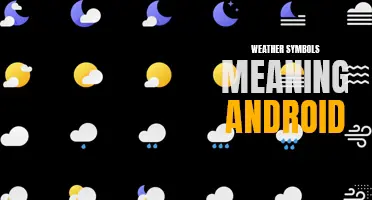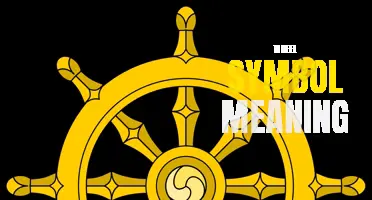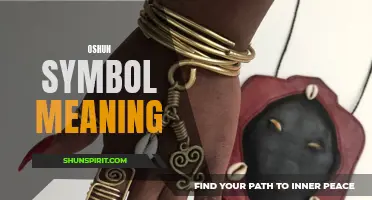
Arabic symbols, steeped in history and significance, have captivated people around the world for centuries. From the intricately designed Arabic calligraphy to powerful geometric patterns, each symbol holds a deep meaning that reflects the rich cultural and spiritual heritage of the Arab world. These symbols not only serve as a form of artistic expression but also convey beliefs, values, and messages that resonate with individuals on a profound level. In this article, we will explore some of the most prominent Arabic symbols and shed light on their hidden meanings, delving into the symbolism that has shaped Arab culture and continues to inspire awe and fascination today.
What You'll Learn
- What are some common Arabic symbols and their meanings?
- How are Arabic symbols used in calligraphy and decorative art?
- Are Arabic symbols universally understood or do interpretations vary across different cultures?
- Can you provide examples of Arabic symbols that have both religious and cultural significance?
- How do Arabic symbols play a role in today's modern society, particularly in communication and design?

What are some common Arabic symbols and their meanings?
Arabic is a rich and beautiful language that has its own set of symbols that are commonly used in everyday life. These symbols carry deep meanings and cultural significance. In this article, we will explore some common Arabic symbols and their meanings.
- Bismillah - "In the name of Allah": Bismillah is often uttered or written before starting any task or activity. It is a phrase that signifies seeking the blessings and protection of Allah.
- Allah - God: This symbol represents the name of God in Arabic. It is commonly used as a decoration in mosques, homes, and Islamic art.
- Crescent Moon and Star - Islam: The crescent moon and star symbolize Islam and are commonly associated with the Muslim faith. This symbol can be found on flags, religious texts, and various Islamic objects.
- Hand of Fatima - Protection: The Hand of Fatima, also known as the Hamsa, is a symbol of protection against the evil eye. It is believed to bring luck, happiness, and ward off negative energy.
- Sword - Courage and strength: The sword is a powerful symbol in Arabic culture. It represents courage, strength, and the ability to face challenges head-on. It is often used to symbolize warriors and leaders.
- Palm Tree - Resilience and prosperity: The palm tree is a symbol of resilience and prosperity in the Arab world. It represents the ability to survive and thrive even in harsh conditions.
- Calligraphy - Beauty and art: Arabic calligraphy is a highly regarded art form. The intricate and flowing designs are often used to write verses from the Quran and other religious texts. Calligraphy is considered a beautiful representation of Arabic culture and art.
- Jasmine - Purity and love: Jasmine is a fragrant flower that holds deep symbolism in Arabic culture. It represents purity, love, and beauty. It is often used in weddings, celebrations, and as a decoration in homes.
- Coffee Pot - Hospitality: The coffee pot, also known as Dallah or Ibrik, is a symbol of hospitality in Arab culture. It represents the tradition of serving coffee to guests as a sign of welcoming and friendship.
- Dates - Fertility and sustenance: Dates are a staple food in Arabic cuisine and hold deep symbolism. They represent fertility, abundance, and sustenance. Dates are often served during special occasions and are considered a valuable source of energy.
These are just a few examples of the many symbols that hold cultural and religious significance in Arabic culture. Each symbol carries its own unique meaning, and they are often used to convey messages and express identity. Learning about these symbols helps to gain a deeper understanding of the rich and diverse Arabic culture.
Understanding the Symbolism Behind the Jainism Symbol
You may want to see also

How are Arabic symbols used in calligraphy and decorative art?
Arabic symbols have been used in calligraphy and decorative art for centuries. Calligraphy, the art of beautiful writing, holds a significant place in Arab culture. Arabic calligraphy is known for its intricate designs and elegant script. Islamic calligraphy, in particular, has played a vital role in the development of decorative art, as symbols and verses from the Quran are often used as inspiration.
Arabic symbols are visually appealing and are carefully chosen to convey meaning and aesthetic beauty. The script itself is a work of art, and it is used to transform written words into visual masterpieces.
Arabic calligraphy utilizes a variety of symbols, including letters, words, and verses. The beauty of this art form lies in the artist's ability to manipulate these symbols and arrange them in a way that is pleasing to the eye. The script can be written in various styles, such as Naskh, Thuluth, or Diwani, each with its own distinct characteristics.
In Islamic calligraphy, verses from the Quran are often used as a source of inspiration. These verses are considered sacred and are carefully selected for their spiritual and aesthetic qualities. The calligrapher skillfully incorporates the chosen verse into the design, carefully considering the shape and form of each symbol to create a balanced and harmonious composition.
Arabic calligraphy is not limited to religious texts, however. It can be found in various forms of decorative art, such as pottery, textiles, and architecture. In these contexts, Arabic symbols are used to add beauty and meaning to the artwork.
One example of the use of Arabic symbols in decorative art is in traditional Moroccan architecture. Intricate patterns and geometric designs decorate buildings, using Arabic symbols as a source of inspiration. These symbols are often repetitively arranged to create mesmerizing patterns that are both visually stunning and culturally significant.
Arabic symbols are also commonly used in Islamic carpets and textiles. These symbols can convey various meanings and can include motifs such as floral designs, geometric shapes, or historical references. The combination of these symbols creates visually stunning patterns that are both symbolic and aesthetically pleasing.
Present-day artists continue to incorporate Arabic symbols in their artwork, exploring new ways to reinterpret traditional calligraphy. This fusion of modern and traditional techniques has resulted in a wide range of contemporary artworks that reflect the rich history and cultural significance of Arabic calligraphy.
In conclusion, Arabic symbols have been used in calligraphy and decorative art for centuries. From Islamic calligraphy to traditional Moroccan architecture and modern-day artworks, these symbols continue to play a significant role in Arab culture. The beauty of Arabic calligraphy lies in its ability to transform written words into visual masterpieces, utilizing carefully chosen symbols to convey meaning and aesthetic beauty.
The Spiritual Significance and Symbolism of Diamonds: Unlocking Their Hidden Meanings
You may want to see also

Are Arabic symbols universally understood or do interpretations vary across different cultures?
Symbols play a crucial role in communication, serving as a visual representation of ideas, concepts, or objects. The interpretation of symbols can vary greatly across different cultures and languages. Arabic symbols, in particular, have a rich history and are widely used in various contexts.
The Arabic language is written from right to left and is known for its beautifully intricate calligraphy. The symbols used in Arabic script are not only letters of the alphabet but also carry deeper meanings. Arabic symbols are often associated with Islamic culture and are commonly seen in religious texts, architecture, and artwork. They hold significant cultural and religious importance for millions of people worldwide.
However, the interpretations of Arabic symbols can vary across different cultures. Cultural and historical contexts play a crucial role in shaping the understanding of these symbols. For example, the symbol of a crescent moon and a star is commonly associated with Islam and is prominently displayed on the flags of several Muslim-majority countries. In this context, the symbol represents not only faith but also unity and strength. It is a symbol that is easily recognizable to Muslims across the globe.
On the other hand, in different cultural contexts, the interpretation of Arabic symbols can differ. Some may view them simply as forms of artistic or decorative expression, while others may not associate any specific meaning with them at all. For instance, someone unfamiliar with Islamic culture may not recognize the significance of symbols like the Arabic word "Allah" or the "Hand of Fatima" (Hamsa) and might interpret them as mere designs.
Furthermore, interpretations of Arabic symbols can also vary within the Arab world itself. Different regions may have their own unique interpretations and associations with specific symbols. For example, the symbol of the palm tree is commonly associated with the Arabian Gulf region and represents hospitality, abundance, and resilience. In contrast, in other parts of the Arab world, such as North Africa, the palm tree symbolizes fertility and prosperity.
In conclusion, the interpretation of Arabic symbols can vary across different cultures and regions. While some symbols may have universal meanings within Islamic culture, others may be subject to interpretation and understanding based on individual cultural contexts. Understanding the cultural and historical significance of Arabic symbols is crucial to avoid misinterpretations and appreciate their true meaning.
The Symbolic Death Meaning: Understanding the Deeper Significance Behind the Final Transition
You may want to see also

Can you provide examples of Arabic symbols that have both religious and cultural significance?
Arabic culture is rich in symbols that have deep religious and cultural significance. These symbols have been part of Arab history and heritage for centuries, representing various beliefs, traditions, and values. From calligraphy to geometric patterns, Arabic symbols have a unique aesthetic appeal.
One of the most well-known Arabic symbols is the crescent moon and star. This symbol has both religious and cultural significance. In Islam, the crescent moon is associated with the beginning of the lunar month and is used to determine the start of Ramadan, the holy month of fasting. The star represents guidance and light. It is often seen on top of mosques and minarets, reflecting the Islamic faith. The crescent moon and star are also widely used as national symbols in many Arab countries.
The Arabic script itself is a symbol that holds significant religious and cultural value. Developed in the 6th century, Arabic calligraphy is considered a form of art and is used to write the Quran, the holy book of Islam. Arabic calligraphy represents a connection between religion, language, and aesthetics. It is often seen in mosques, Quranic manuscripts, and Islamic artwork.
Another Arabic symbol with religious and cultural significance is the palm tree. In the Quran, palm trees are mentioned several times and are often associated with paradise and blessings. The palm tree is a symbol of fertility, abundance, and resilience in Arab culture. It is an integral part of the desert landscape and has been a source of sustenance for many generations.
The hamsa hand, also known as the Hand of Fatima, is a popular Arabic symbol believed to ward off evil spirits and bring good luck. The hamsa hand is shaped like an open hand with an eye in the center. It is often worn as a protective amulet and can be seen in jewelry, home decor, and art. The symbol is derived from Fatima Zahra, the daughter of Prophet Muhammad, and holds religious significance for Muslims.
Arabic geometric patterns are another form of symbolism that is widely used in Islamic art and architecture. These intricate and symmetrical patterns are based on mathematical principles and serve as a visual representation of the unity and harmony found in the Islamic faith. The repeating geometric motifs can be found in mosques, madrasas, and palaces throughout the Arab world.
In conclusion, Arabic symbols hold both religious and cultural significance. From the crescent moon and star to Arabic calligraphy and geometric patterns, these symbols represent the faith, traditions, and values of the Arab people. They serve as a visual language that connects communities and preserves the rich heritage of the Arab culture.
The Definitive Guide to Icon Cash App Symbols and Their Meanings
You may want to see also

How do Arabic symbols play a role in today's modern society, particularly in communication and design?
Arabic symbols have a rich historical and cultural significance, and they continue to play a significant role in today's modern society, particularly in communication and design. These symbols carry deep meanings and convey messages that are still relevant and impactful. From calligraphy to architectural elements, Arabic symbols have made their way into various aspects of contemporary life.
In the realm of communication, Arabic symbols have become more accessible and familiar to people around the world due to the widespread use of technology and globalization. Many social media platforms now offer Arabic language support, allowing users to incorporate Arabic symbols into their messages, posts, and hashtags. This has led to a greater appreciation for the beauty of Arabic calligraphy and the diverse range of symbols it encompasses.
Arabic symbols are no longer limited to traditional mediums such as books and etchings; they have also found their way into modern graphic design and art. The distinctive and intricate nature of Arabic calligraphy makes it an ideal choice for logos, branding, and typography. Designers often incorporate Arabic symbols into their work to add a touch of sophistication, cultural depth, and uniqueness.
Moreover, Arabic symbols have also permeated various architectural designs around the world. With their geometric patterns and intricate designs, Arabic symbols have become an integral part of mosque architecture, both traditional and contemporary. Many modern architects draw inspiration from the historical beauty of Arabic symbols when designing buildings, creating stunning masterpieces that pay homage to Arabic culture and heritage.
Arabic symbols not only add aesthetic value but also hold significant meaning in contemporary society. Some symbols, such as the crescent moon and star, have become universally recognized representations of Islam. These symbols connect people of different cultures and serve as a unifying force, fostering a sense of belonging and identity.
In recent years, Arabic symbols have been used as a form of protest and political expression. They have been utilized in street art, murals, and graffiti to convey powerful messages, challenge social norms, and demand change. The symbolic nature of these symbols allows individuals to express their thoughts and sentiments in a visually compelling manner, transcending language barriers.
It is essential to acknowledge and appreciate the historical and cultural context behind Arabic symbols to ensure their accurate representation and usage in today's modern society. When incorporating these symbols into communication and design, it is crucial to understand their intended meanings and respect the cultural significance attached to them.
In conclusion, Arabic symbols continue to play a significant role in today's modern society, particularly in communication and design. Their beauty, complexity, and historical significance make them ideal for expressing ideas, fostering cultural connections, and adding a touch of elegance to various visual mediums. As long as they are used with respect and knowledge of their cultural context, Arabic symbols will continue to enrich contemporary society and contribute to the global exchange of ideas and aesthetics.
Unveiling the Symbolic Meaning Behind Cascarones: Exploring the Rich Cultural Significance
You may want to see also
Frequently asked questions
The crescent and star symbol, commonly associated with the Islamic faith, is a widely recognized symbol of the religion. The crescent symbolizes the new moon, which marks the beginning of the Islamic lunar month and is used to determine the timing of religious observances. The star, on the other hand, represents the light of knowledge and guidance. Together, the crescent and star symbolize the Muslim faith and its adherence to the principles of Islam.
The hand of Fatima, also known as the Hamsa or the Hand of God, is a symbol commonly used in Arabic and Middle Eastern cultures. It is believed to protect against evil spirits, negative energies, and the evil eye. The symbol features an open right hand with an eye in the center, symbolizing the ability to see and ward off evil. The hand of Fatima is often worn as a talisman for protection and good luck.
Arabic calligraphy is an integral part of Islamic art and holds great significance in the Muslim world. It is considered a visual expression of the divine word of Allah (God) as revealed in the Qur'an. Arabic calligraphy is admired for its intricate and decorative styles, with each letter being carefully crafted to create beautiful compositions. It is used to adorn mosques, manuscripts, textiles, and other forms of Islamic art, serving as a means to convey the message of the Qur'an and enhance the spiritual experience of viewers.







